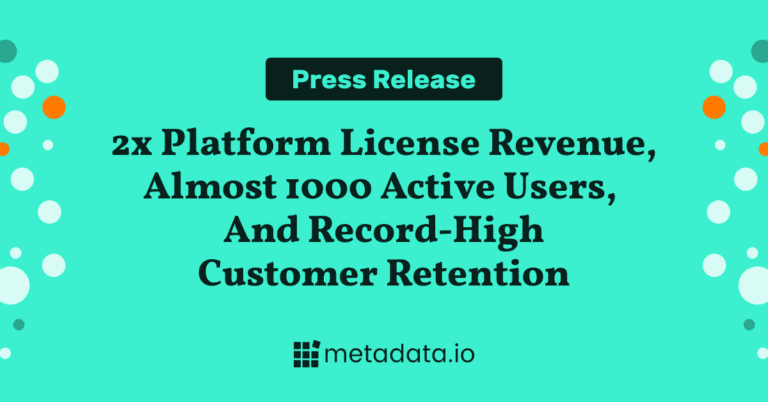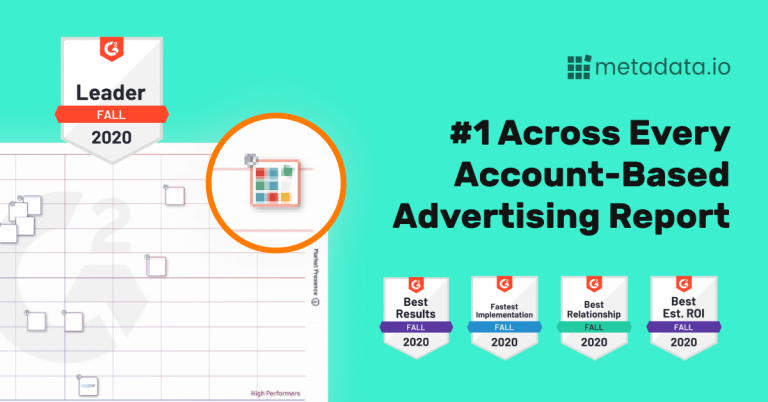Managing Your Paid Media Budget Like a Performance Marketing Pro
This is the second post in our new content series, Meta With Metadata. We’re giving you an inside look at how our Marketing team uses our own product to automate paid campaigns and drive more revenue.
How can I get something out of nothing?
That’s the question every demand gen marketer is asking themselves right now.
If you’re a demand gen marketer, you’re used to hearing, “Hey, times are tough, but I need you to double your results with half the budget. Oh, and we’re cutting your team down 50%.”
For the foreseeable future, you need to get scrappy. You need to find ways to hit paid home runs without the Louisville Slugger you’re used to. There’s no better place to start than getting more out of your budget.
How we’re staying nimble with our paid media budget
As last year ended, we shifted the conversation around our demand gen strategy. Instead of double clicking on the “do more with less” way of thinking, I think it’s time to consider the importance of diversifying your channel mix.
I’ve always been in favor of hedging my bets with a healthy mix of organic posts and paid ads. Even though the economy is in the dumps, we still believe advertising during a recession is a winning move.
With that said, obviously most teams are pivoting right now.
For the Metadata team, that means testing new channels like our DEMAND community and email marketing.
To keep your demand gen engine turned on for the rest of 2023, you can start thinking about diversifying channels into two buckets—demand creation and demand capture.
Demand creation vs. demand capture: a tale as old as time
When I think about the pre-pandemic days when you didn’t need to take out a second mortgage to buy eggs and TikTok had less than 100 million users, I relish the thought of demand creation.
I’d say about 70% of our budget went to creating demand via no-ask tactics. We focused on providing value without expecting anything in return.
The rest of our budget went to tactics aimed at turning demand into opportunities.
- Creation: Demand creation builds affinity, trust, and interest in your product or category via tactics. When setting your sights on demand creation, you’re often going for a long-term play. Think running a weekly podcast or engaging in relevant communities.
- Capture: Demand capture converts in-market buyers who know they have a problem and are actively looking for a solution to solve it. This focuses on audiences and channels with intent, such as like high-intent keywords (paid and organic) and remarketing.
If this were 2018, I’d tell you to allocate your budget however your heart desires. But it’s not, and that advice would be reckless.
Instead, I’ll tell you this (keep reading)…
How to capture demand like a performance marketing pro
I could tell you that targeting high-intent keywords, getting your review profiles in order, and retargeting people who visit high-intent pages would help you capture demand in 2023—and they would. But I want to go deeper and look at more tactical ways you can manage your budget.
I’m talking about budget groups, experimentation, and automation.
Group audiences by goals
Everything I do in 2023 aims to give Metadata a better vantage point into which parts of our demand generation engine are working.
Budget groups in our platform help us do just that.
What’s a budget group?
In Metadata, you can allocate a certain amount of spend towards specific channels and goals. We call these budget groups. They help you cast a wider net and identify the tactics driving the most efficient results. Without budget groups, you’d be hard-pressed to gain variable-level clarity into how your campaigns are performing.
Here are some examples from our playbook on building a full-funnel campaign:

That’s what makes budget groups so great. If you want to see if something will resonate with your target audience or save you money, create a budget group, and you’ll have an answer in less time than it takes Elon to deliver a Tesla.
That’s what we do (the budget groups, not the Tesla), and we’ve walked away with learnings that have dramatically impacted our spending.
For example, we learned that LinkedIn Conversation Ads weren’t quite as shiny as they were when we raved about them in our 2022 benchmark report. In less than a year, they went from our BFF to that so-so friend you give a subtle nod to when you see them.
They’re still important, and we’re paying attention, but we’re not obsessed. We’re spending our energy—and budget—elsewhere.
Pro tip: While creating an endless stream of budget groups is tempting, stick to a few that’ll help you drive short-term gains. For example, instead of creating a budget group for TOFU content typically reserved for demand creation, focus on BOFU content that can convert in-market buyers this quarter.
Experiment like it’s no one’s business
I can’t manage my budget if I don’t know what’s working, and I can’t know what’s working if I can’t throw my spend around and see what sticks.
Experiments can be one of the most cost-effective ways to manage your budget.
What’s an experiment?
Metadata defines an experiment as a unique combination of campaign elements, including audiences, messaging, creative, and content, to discover what works, what doesn’t, and why.
Ok, great. But that opens Pandora’s box.
If you find yourself struggling to figure out where to launch your experimentation strategy, consider the three As that Silvio Perez, outlined in his DEMAND session, How to Experiment with Your Paid Campaigns (and Drive Revenue):
- Audience: Who’s seeing your ads?
- Ads: Which ad types resonate the most?
- Assets: Which messaging is hitting home?
Silvio suggests that this should be your order of focus, and I couldn’t agree more. The best way to manage your budget is to make sure you’re getting your ads in front of the right people.
Run as many experiments as you need to wrap your head around how to build an audience that perfectly aligns with your ideal customer profile (ICP).
From there, run experiments to figure out which ads, audiences, and assets resonate. Then, throw your budget at the budget groups that mix and match the right puzzle piece (or have Metadata do it for you).
Optimize your paid media budget…automatically
Do you want to make a room of demand gen marketers shutter in fear?
Of course not, but if you did, let them know they burned through their monthly budget in three days.
Now tell them that despite the spend fest, their pipeline hasn’t increased at all, and there are only a few more leads in their CRM.
We’ve all been there—and it sucks.
Unfortunately, that’s the name of the game in demand gen, especially if you’re running campaigns through native ad channels.
You know the drill.
You log into Facebook, LinkedIn, or Google first thing in the morning to see how your campaigns are shaping up. You do some calculations in a spreadsheet, check to see if pacing is on track, and pull the levers necessary to make sure your budget goes to the ads driving the best return.
Unless you’re a wizard, some performance and efficiency gains will forever be glued to the table. You could mess up a calculation or miss something in your spreadsheet due to bandwidth.
A lot could prevent you from truly understanding how your campaigns are performing and the steps you could take to make them even better.
You’re human, but why not bring a friend along for the ride?
Let’s call that friend Metadata and think of them as that trusty sidekick who ensures you don’t miss opportunities to do something great. In the context of paid advertising, that means proper pacing and optimizing toward the budget groups and experiments performing best.
Auto-pause FTW
Didn’t get the reaction from the B2B crowd you were looking for when you told them their pacing went on the fritz? No problem. Tell them they just invested thousands on an experiment that bombed.
Metadata’s auto-pause setting makes sure this doesn’t happen by automatically shutting down the lagging campaigns and moving that budget elsewhere.

Silvio Perez
Manage your paid media budget without pulling your hair out
I’m sure you’re under more pressure than ever to manage your budget in the smartest way possible. Budget groups, experimentation, and automation will help you do that.
Unfortunately, doing that in native ad channels is tricky, primarily because your budget sits at the campaign level.
Because of this pitfall, budget groups aren’t a thing, making it next to impossible to run experiments that give you granular-level insight into what’s working across your audiences, ads, and assets.
The outcome? Inefficient—and manual—budget allocation.
If you ask me, that’s no way to manage your budget, especially in 2023.



